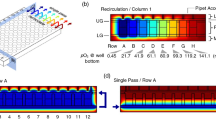Summary
In preparing for the routine use of the ubiquitous in vitro cell growth inhibition assay for the study of anticancer agents, we characterized the statistical properties of the assay and found some surprising results. Parabolic well-to-well cell growth patterns were discovered, which could profoundly affect the results of routine growth inhibition studies of anticancer and other agents. Four human ovarian cell lines, A2780/WT, A2780/DX5, A2780/DX5B, and A121, and one human ileocecal adenocarcinoma cell line, HCT-8, were seeded into plastic 96-well plates with a 12-channel pipette, without drugs, and grown from 1–5 d. The wells were washed with a plate washer, cells stained with sulforhodamine B (SRB), and dye absorbance measured with a plate reader. Variance models were fit to the data from replicates to determine the nature of the heteroscedastic error structure. Exponential growth models were fit to data to estimate doubling times for each cell line. Polynomial models were fit to data from 10-plate stacks of 96-well plates to explore nonuniformity of cell growth in wells in different regions of the stacks. Each separate step in the assay was examined for precision, patterns, and underlying causes of variation. Differential evaporation of water from wells is likely a major, but not exclusive, contributor to the systematic well-to-well cell growth patterns. Because the fundamental underlying causes of the parabolic growth patterns were not conclusively found, a randomization step for the growth assay was developed.
Similar content being viewed by others
References
Alley, M. C.; Scudiero, D. A.; Monks, A., et al. Feasibility of drug screening with panels of human cell lines using a microculture tetrazolium assay. Cancer Res. 48:589–601; 1988.
Boyd, M. R.; Paull, K. D. Some practical considerations and applications of the National Cancer Institute in vitro anticancer drug discovery screen. Drug Dev. Res. 34:91–109; 1995.
Crickard, K.; Niedbala, M. J.; Crickard, U., et al. Characterization of human ovarian and endometrial carcinoma cell lines established on extracellular matrix. Gynecol. Oncol. 32:163–173; 1989.
Ferron, G. M.; Pyszczynski, N. A.; Jusko, W. J. Gender-related assessment of cyclosporin/prednisolone/sirolimus interactions in three human lymphocyte proliferation assays. Transplantation 65:1203–1209; 1997.
Grever, M. R.; Schepartz, S. A.; Chabner, B. A. The National Cancer Institute: cancer drug discovery and development program. Semin. Oncol. 19:622–638; 1992.
Jamali, M. A. A.; Yin, M.-B.; Mazzoni, A.; Bankusli, I.; Rustum, Y. M. Relationship between cytotoxicity, drug accumulation, DNA damage and repair of human ovarian cancer cells treated with doxorubicin: modulation by the tiapamil analog R011-2933. Cancer Chemother. Pharmacol. 25:77–83; 1989.
Levasseur, L.; Faessel, H.; Slocum, H. K.; Greco, W. R. Precision and pattern in 96-well plate growth experiments. Proc. Am. Stat. Assoc. Biopharm. Sect. 227–232; 1995.
Levasseur, L. M.; Greco, W. R.; Rustum, Y. M.; Slocum, H. K. Combinedaction of paclitaxel and cisplatin against wildtype and resistant human ovarian carcinoma cells. Cancer Chemother. Pharmacol. 40:495–505; 1997.
Rogan, A. M.; Hamilton, T. C.; Young, R. C., et al. Reversal of adriamycin resistance by verapamil in human ovarian cancer. Science (Wash DC) 224:994–996; 1984.
Rubinstein, L. V.; Shoemaker, R. H.; Paull, K. D., et al. Comparison of in vitro anticancer-drug-screening data generated with a tetrazolium assay versus a protein assay against a diverse panel of human tumor cell lines. J. Natl. Cancer Inst. 82:1113–1118; 1990.
Skehan, P.; Storeng, R.; Scudiero, D., et al. New colorimetric cytotoxicity assay for anticancer-drug screening. J. Natl. Cancer Inst. 82:1107–1112; 1990.
Vanhoefer, U.; Shousong, C.; Minderman, H., et al. PAK-104P, a pyridine analogue, reverses paclitaxel and doxorubicin resistance in cell lines and nude mice bearing xenografts that overexpress the multidrug resistance protein. Clin. Cancer Res. 2:369–377; 1996.
Author information
Authors and Affiliations
Rights and permissions
About this article
Cite this article
Faessel, H.M., Levasseur, L.M., Slocum, H.K. et al. Parabolic growth patterns in 96-well plate cell growth experiments. In Vitro Cell.Dev.Biol.-Animal 35, 270–278 (1999). https://doi.org/10.1007/s11626-999-0071-z
Received:
Accepted:
Issue Date:
DOI: https://doi.org/10.1007/s11626-999-0071-z




